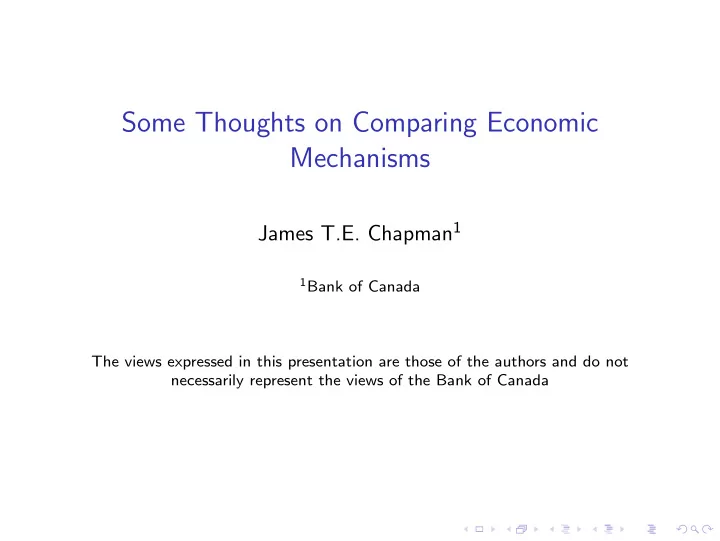

Some Thoughts on Comparing Economic Mechanisms James T.E. Chapman 1 1 Bank of Canada The views expressed in this presentation are those of the authors and do not necessarily represent the views of the Bank of Canada
A Fundamental Diagram of Structural Econometrics Outcome Space Environment Θ Z
A Fundamental Diagram of Structural Econometrics Outcome Space Environment Θ Z µ ( θ ) h M Message Space
A Fundamental Diagram of Structural Econometrics Outcome Space Environment Θ Z µ ( θ ) h M Message Space
A Fundamental Diagram of Structural Econometrics Estimation Outcome Space Environment Θ Z µ ( θ ) h M Message Space
A Fundamental Diagram of Structural Econometrics Counter factual exercise Outcome Space Environment Θ Z µ o ( θ ) h o M o Message Space
Bank of Canada Auctions ◮ The Bank is the fiscal agent of the Federal Government
Bank of Canada Auctions ◮ The Bank is the fiscal agent of the Federal Government ◮ Part of its instruments for this function are the Reciever General (RG) term deposit auctions
Bank of Canada Auctions ◮ The Bank is the fiscal agent of the Federal Government ◮ Part of its instruments for this function are the Reciever General (RG) term deposit auctions ◮ These are multi-unit discriminatory auctions held twice (or more) daily
Bank of Canada Auctions ◮ The Bank is the fiscal agent of the Federal Government ◮ Part of its instruments for this function are the Reciever General (RG) term deposit auctions ◮ These are multi-unit discriminatory auctions held twice (or more) daily ◮ The Bank has two conflicting goals: revenue maximization on behalf of the government and promotion of financial market efficiency (allocative efficiency in this case)
Empirical Auction Design Applied to the BoC RG Auctions ◮ We estimate possible environments that caused the observed outcomes of the auctions
Empirical Auction Design Applied to the BoC RG Auctions ◮ We estimate possible environments that caused the observed outcomes of the auctions ◮ We then consider a mechanism, the Generalized Vickery Auction (GVA), that in the context we study achieves allocative efficiency
Empirical Auction Design Applied to the BoC RG Auctions ◮ We estimate possible environments that caused the observed outcomes of the auctions ◮ We then consider a mechanism, the Generalized Vickery Auction (GVA), that in the context we study achieves allocative efficiency ◮ We find counter factual levels of revenue and efficiency losses in comparison to the multi-unit discriminatory auction
Empirical Auction Design Applied to the BoC RG Auctions ◮ We estimate possible environments that caused the observed outcomes of the auctions ◮ We then consider a mechanism, the Generalized Vickery Auction (GVA), that in the context we study achieves allocative efficiency ◮ We find counter factual levels of revenue and efficiency losses in comparison to the multi-unit discriminatory auction ◮ This is important since the multi-unit discriminatory auction is not efficient; but it may provide higher expected revenue.
Results From the Empirical Comparison ◮ Changing to the mechanism that achieves allocative efficiency would result in:
Results From the Empirical Comparison ◮ Changing to the mechanism that achieves allocative efficiency would result in: ◮ A loss of at most $1038.22 in expected revenue
Results From the Empirical Comparison ◮ Changing to the mechanism that achieves allocative efficiency would result in: ◮ A loss of at most $1038.22 in expected revenue ◮ A gain in efficiency of at least $0.0045
Some Concluding Thoughts ◮ This work built on the ideas of all three nobel laureates. Either in terms of general ideas (Hurwicz), or specific research (i.e. Myerson’s research into optimal auctions, Maskin’s research in efficient auctions)
Some Concluding Thoughts ◮ This work built on the ideas of all three nobel laureates. Either in terms of general ideas (Hurwicz), or specific research (i.e. Myerson’s research into optimal auctions, Maskin’s research in efficient auctions) ◮ This work also makes two points about mechanism design:
Some Concluding Thoughts ◮ This work built on the ideas of all three nobel laureates. Either in terms of general ideas (Hurwicz), or specific research (i.e. Myerson’s research into optimal auctions, Maskin’s research in efficient auctions) ◮ This work also makes two points about mechanism design:
Some Concluding Thoughts ◮ This work built on the ideas of all three nobel laureates. Either in terms of general ideas (Hurwicz), or specific research (i.e. Myerson’s research into optimal auctions, Maskin’s research in efficient auctions) ◮ This work also makes two points about mechanism design: ◮ Optimal mechanisms (e.g. GVA) can empirically be very different from non-optimal mechanisms (e.g. multi-unit auction)
Some Concluding Thoughts ◮ This work built on the ideas of all three nobel laureates. Either in terms of general ideas (Hurwicz), or specific research (i.e. Myerson’s research into optimal auctions, Maskin’s research in efficient auctions) ◮ This work also makes two points about mechanism design: ◮ Optimal mechanisms (e.g. GVA) can empirically be very different from non-optimal mechanisms (e.g. multi-unit auction) ◮ Optimal mechanisms may be hard to implement in real life for potentially little reward.
Recommend
More recommend